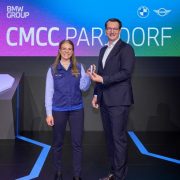Expertise built into every cell: BMW Group produces battery cell samples in Parsdorf
26.10.2023

Munich/Parsdorf. A tiny piece of the future began rolling off the production line in Parsdorf today: 95 millimetres tall, cylinder-shaped, with a diameter of 46 millimetres. These are the new battery cell samples – like those that will be used in the models of the Neue Klasse from 2025 onwards – being produced at the new Cell Manufacturing Competence Centre (CMCC) in Parsdorf. The BMW Group is thus positioning itself to ramp up electromobility efficiently and showcasing its leading role in battery cell technology.
“With the Cell Manufacturing Competence Centre, we are strengthening Germany’s capacity for innovation,” explained Milan Nedeljković, member of the Board of Management of BMW AG, responsible for Production. “In this way, we are making an important contribution to the quantum leap in technology in the Neue Klasse.”
“Production of battery cell samples in Parsdorf marks the next logical step in our battery cell strategy,” said Frank Weber, member of the Board of Management of BMW AG, responsible for Development. “The Cell Manufacturing Competence Centre is the perfect complement to our existing Battery Cell Competence Centre in the north of Munich. Development takes place there, then we scale the best product towards a series process in Parsdorf. Thanks to cross-divisional collaboration, we are able to link product and process in a unique way.”
The CMCC in Parsdorf will enable the BMW Group to span the whole cell value creation process. With this know-how, the company is setting benchmarks for production, quality, performance, costs and environmental standards, which it is implementing in close cooperation with its partners for standard production of battery cells. At its battery cell competence centres in Munich and Parsdorf, the BMW Group is systematically pursuing future milestones, such as the ramp-up of the sixth generation of BMW electric drive trains and development of all-solid-state batteries (ASSB). About 80 employees work at the 15,000-square-metre Cell Manufacturing Competence Centre, which has benefited from a total investment of around 170 million euros. The German Federal Ministry of Economic Affairs and the Bavarian Ministry of Economic Affairs, Regional Development and Energy are supporting the project within the framework of the European funding process IPCEI (Important Projects of Common European Interest).
Recycling at the CMCC: Keeping materials in the loop
Raw materials are among the significant cost factors for cell production. Efficient and responsible use of raw and carrier material is therefore necessary and makes sense from both an environmental and economic perspective. At the new CMCC, experience will be gained from all processes and the lessons learned analysed to further optimise the use of resources. Residual materials from the production process will be collected at the CMCC, sorted and fed back into the cell production cycle. In addition to working on the cell manufacturing process, BMW Group experts are also focusing on reusing materials and components from the whole battery after its initial use in the vehicle.
At the Battery Cell Competence Centre (BCCC) in Munich, the first battery cells made from 100% recycled and/or secondary (battery-grade) cathode material have been manufactured and tested using state-of-the-art characterisation methods. Our cell suppliers are already delivering battery cells containing secondary raw materials (e.g. nickel) from various used-battery sources (incl. production waste). The long-term aim of the BMW Group is to reuse all raw materials in recyclable high-voltage batteries.
How the cell is created: Production steps for sample manufacturing at the CMCC
Cell manufacturing begins with electrode production. Here the base material, comprising, for example, graphite for the anode and nickel oxides for the cathode, with binders and solvents, is metered and mixed in a precisely measured ratio. This creates the so-called “slurry” – which means wafer-thin metal foils are coated and then compressed after drying. In technical jargon, this is referred to as “calendering”. The highest level of precision is required: The foil is just a few micrometres thick – in other words, thinner than the threads of a spider web, while the coating is in the micrometre range. During cell assembly, the coated foils, referred to as calendered electrodes, are wound into so-called “jelly rolls” using the separator and inserted into the cell housing. The cells are filled with electrolyte, then charged for the first time and finally checked for functionality and quality.
CMCC Parsdorf: Buildings with a focus on the environment
The CMCC in Parsdorf is built to high environmental standards. An immission control approval procedure has been carried out for the technical installations used in battery cell production – ensuring that the company complies with all requirements and guidelines. The CMCC will also operate fossil-free, relying on electricity produced using renewable energy, including from photovoltaic systems on the roof of the building. The building will also be supplied with regenerative heat produced using state-of-the-art groundwater and air heat pumps.
Sixth-generation BMW battery technology: New cell format and enhanced cell chemistry
The battery cell is responsible for electric vehicles’ core properties: range, driving performance and charging time. With the new BMW round cell specially designed for the electric architecture of the Neue Klasse models, it will be possible to significantly increase the range of the top model by up to 30 percent (according to WLTP).
The new BMW round cells come with a standard diameter of 46 millimetres and two different heights of 95 millimetres and 120 millimetres. Compared to the prismatic cells of the fifth BMW battery cell generation, the nickel content of the sixth-generation BMW round cells will be higher on the cathode side, while the cobalt content will be reduced. On the anode side, the silicon content will be increased. As a result, the cell’s volumetric energy density will improve by more than 20 percent.
Battery, drive train and charging technology in the Neue Klasse will have a higher voltage of 800 volts. Among other things, this will optimise how energy is supplied to direct current high-power charging stations, which can achieve a much higher charging capacity with a current of up to 500 amperes – thus reducing the time it takes to charge from ten to 80 percent by up to 30 percent.
Reducing the carbon footprint of battery cell production by up to 60 percent
The BMW Group is particularly focused on keeping the carbon footprint and resource consumption of production as low as possible, starting in the supply chain. For standard production of battery cells, the cell manufacturers commissioned will use cobalt, lithium and nickel containing secondary material. Together with the commitment by its cell suppliers to use only green power from renewable energies in production, the BMW Group will reduce the carbon footprint from battery cell production by up to 60 percent, compared to the current generation of battery cells.
Source:Expertise built into every cell: BMW Group produces battery cell samples in Parsdorf




